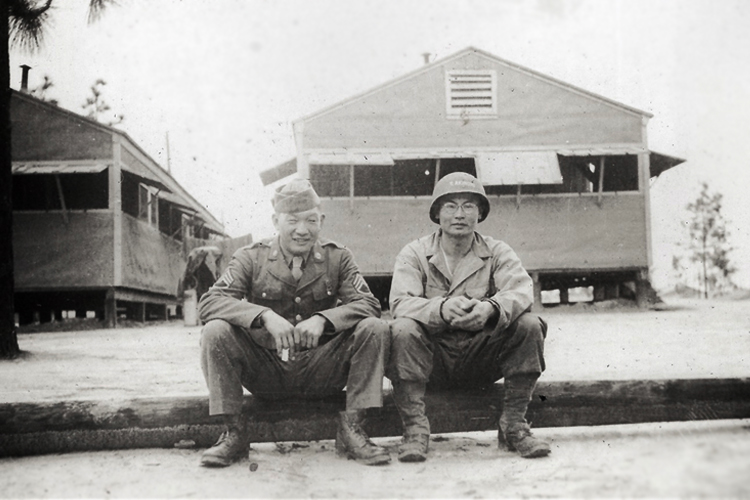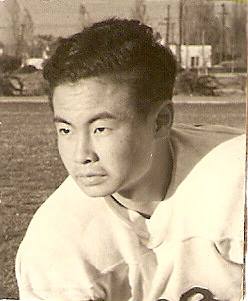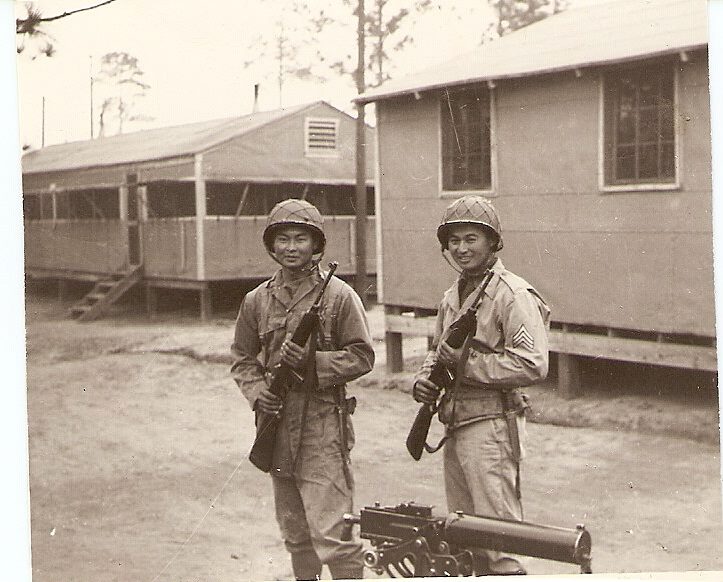Private First Class John Akimoto

- Unit: 100th Infantry Battalion, Company C
- Service Number: 37344336
- Date of Birth: September 22, 1922
- Entered the Military: March 26, 1943
- Date of Death: August 2, 1944
- Hometown: Los Angeles, California
- Award(s): Bronze Star
- Cemetery: Plot A, Row 14, Grave 42. Lorraine American Cemetery, Saint-Avold, France
Singapore American School
2014-2015
Early Life
John “Johnny” Akimoto was born on September 22, 1924 to Masanori and Mary “Miki” Shiratori Akimoto. He was the last of seven children and the youngest of four brothers. After spending his early years in Idaho Falls, Idaho, he moved with his family to Los Angeles, California in 1928. He attended 36th Street Elementary School, Forshay Junior High School, and Dorsey High School in Los Angeles. He planned to go on to college like his oldest brother, Ned. However, his plans were interrupted.
Japan bombed Pearl Harbor, Hawaii on December 7, 1941. A few weeks later, in early 1942, President Franklin D. Roosevelt issued Executive Order 9066. This executive order authorized the military to remove people from their homes that were considered “enemy aliens” of the United States, specifically, Japanese Americans along the West Coast. The U.S. government relocated Akimoto and his family to the Santa Anita Race Track Civilian Assembly Center.
The family used their Idaho connections to become farm laborers in the sugar beet fields near Lincoln, Idaho. Later, Akimoto and then his parents moved to the Amache Internment Camp in Colorado. On April 7, 1943, Akimoto was one of the first two volunteers for the 100th Infantry Battalion from the Amache Internment Camp.



Military Experience
Akimoto received his basic training at Camp Shelby, Mississippi. His brothers, Victor and Ted, and his brother-in-law, Bill Kajikawa, joined him there. At Camp Shelby, Akimoto received training as a machine gunner for the 100th Infantry Battalion/442nd Regimental Combat Team, C Company. His first assignment was to replace troops destined for the Italian campaign.
Anzio, Italy
He served in the Battle of Anzio and the Rome to Arno Campaign in Italy. In late 1943, Akimoto landed on the beaches near Anzio, Italy. This was an important part of the southern European campaign for the Allies due to its close proximity to Rome. The objective was to capitalize on the victories in North Africa by continuing to pressure the Axis in southern Europe. By doing so, the Allies could better prepare for a full scale invasion at Normandy in summer 1944 and help to reduce the tremendous battering that the Russians were withstanding on the eastern front.
The battle for Anzio started in January 1944 and lasted for nearly five months. Akimoto’s unit replaced the troops killed or injured in the initial landings and battles. The terrain was terrible. The Allied troops were stuck in a vast marshland surrounded by German and Italian troops who could shoot from the hillsides. The battle saw nearly 40,000 Allied casualties, including 7,000 killed and 33,000 wounded or missing in action. While in combat, Akimoto earned a Bronze Star for his bravery.



Eulogy
Private First Class Akimoto became ill and died of acute hepatitis on August 2, 1944. He was awarded the Bronze Star, European-African-Middle Eastern Theatre Medal, Good Conduct Medal, Victory Medal, and Combat Infantryman’s Badge. Akimoto’s contributions helped the 100th Infantry Battalion, 442nd Regimental Combat Team receive over 18,000 individual decorations making them the most decorated unit in U.S. military history. He is buried in the Lorraine American Cemetery in Saint-Avold, France, the largest of the American World War II cemeteries in Europe. Next to him lies his brother, Private Victor Akimoto, in a section where 26 brothers are laid to rest. To learn more about the Akimoto family’s experiences during World War II, please download the book, When the Akimotos Went to War.


Reflection
Bibliography
“7 Utahans Dead, 7 Wounded, 1 Safe, 1 Freed, 2 Lost.” The Salt Lake Tribune, May 3, 1945: Sec 2, 6.
“442nd Organizational Chart.” Sons and Daughters of the 442nd Regimental Combat Team. Accessed February 22, 2015. 442sd.org/category/442nd-organizational-chart/.
“Akimoto and Yasuda will report to Denver April 6.” Granada Pioneer, March 31, 1943. cdmweb.lib.csufresno.edu/cdm/ref/collection/SVJAinWWII/id/1291.
Akimoto Family Photographs. 1890 – 2011. Courtesy of Sara Akimoto.
Akimoto, Ted. Various Photographs from Japan. Photographs. 1945. World War II Road Show, University of Massachusetts at Boston. www.massmemories.net/WWII.php?pageNum_Images=2.
Akimoto, Ted. “Memoirs of Theodore Akimoto.” Akimoto Family Collection. Boston, Massachusetts.
Akimoto, Theodore. “World War II Japan After the Surrender.” Photograph narration. Audio File, 8:32. WGBH Educational Foundation. streams.wgbh.org/online/specials/war/akimoto/index.html.
Akimoto, Ted, and K. Baishiki. “PFC. Johnny Akimoto.” Last modified 2001. Accessed March 17, 2015. Akimoto Family Collection.
“Anzio 1944.” U.S. Army Center for Military History. Last modified January 21, 2010. Accessed February 22 2015. www.history.army.mil/brochures/anzio/72-19.htm.
Asahina, Robert. Just Americans: How Japanese Americans Won a War at Home and Abroad. New York: Gotham, 2006.
“Asian American and Pacific Islander Heritage Month: Honoring Japanese-Americans from the 442nd.” American Battle Monuments Commission. Accessed February 22, 2015. www.abmc.gov/news-events/news/asian-american-and-pacific-islander-heritage-month-honoring-japanese-americans#.VOmqC7COHfa.
“Bruyeres and Biffontaine.” Go for Broke National Education Foundation. Accessed February 22, 2015. www.goforbroke.org/history/history_historical_campaigns_bruyeres.php.
Chakales, L. S. “Nisei Japanese on Our Side Make Crack Regiment of the War.” San Antonio Express, October 21, 1945: 6.
The Denver Post. “Amache Japanese-American Internment Camp.” The Archive. Last modified February 26, 2013. Accessed February 22, 2015. blogs.denverpost.com/library/2013/02/26/amache-japanese-internment-camp/6790/.
Dumas, Jerry. “He loved country, even when country didn’t love him.” GreenwichTime, February 2, 2011. www.greenwichtime.com/local/article/Dumas-He-loved-country-even-when-country-didn-t-992907.php.
Duss, Masayo. Unlikely Liberators: The Men of the 100th and 442nd. Honolulu: University of Hawaii, 1987.
“Executive Order No. 9066, February 19, 1942.” National Archives and Records Administration. Accessed August 4, 2015. www.ourdocuments.gov/doc.php?flash=true&doc=74.
Grapes, Bryan J. Japanese American Internment Camps. San Diego: Greenhaven, 2001.
“Horace (Stanley) Kango Sagara.” 100th Infantry Battalion Veterans. Accessed February 22, 2015. www.100thbattalion.org/archives/photos/n-s/horace-stanley-kango-sagara/.
Ikeda, Tom. “Sites.” Densho. Last modified February 20, 2015. Accessed February 21, 2015. www.densho.org/sitesofshame/facilities.xml.
“John Akimoto.” American Battle Monuments Commission. Accessed February 22, 2015. www.abmc.gov/search-abmc-burials-and-memorializations/detail/WWII_40583#.VOmiA7COHfZ.
Kanaya, Jimmie. “Out on patrol and being captured near the Lost Battalion.” National World War II Museum. Last modified 2013. Accessed February 22 2015. www.ww2online.org/view/jimmie-kanaya/segment-3/60151.
Masuda, Minoru, Hana Masuda, and Dianne Bridgman. Letters from the 442nd: The World War II Correspondence of a Japanese American Medic. Seattle: University of Washington, 2008.
Japanese-American Internment. Evanston: Nextext — McDougal Littell, 2000.
John Akimoto, Official Military Personnel File, Department of the Army, RG 319, National Archives and Records Administration – St. Louis.
John Akimoto, Individual Deceased Personnel File, Department of the Army.
Letters from Johnny Akimoto to Akimoto Family Members, 1942 – 1944. Courtesy of Gay Sato.
Letters from Victor Akimoto to Akimoto Family Members, 1942 – 1944. Courtesy of Gay Sato.
Lillquist, Karl. Imprisoned in the Desert: The Geography of World War II-Era, Japanese American Relocation Center in the Western United States. Ellensburg: Central Washington University, 2007. www.cwu.edu/geography/geography-japanese-american-relocation-centers.
McIlwain, James. “Soldiers and the Camps.” Brown University. Accessed December 14, 2014. charlotte.neuro.brown.edu/~jamesmcilwain/SOLDIERS%20AND%20THE%20CAMPS.pdf
Memorial Service For Japanese American Soldiers Who Died In World War II. Photograph. c. 1945. Japanese American Archival Collection Imagebase, Sacramento State University. digital.lib.csus.edu/cdm/ref/collection/jaac/id/632.
“Occupational Records for Akimoto, Masanori.” Japanese Immigrants to the United States, 1887-1924. Brigham Young University, Idaho. Accessed February 22, 2015. abish.byui.edu/specialCollections/fhc/Japan/occupations.asp?name_id=1806.
“Photo Gallery: Battalion Scrapbook.” The Honolulu Advertiser. Last modified June 17, 2007. Accessed February 22, 2015. the.honoluluadvertiser.com/article/2007/Jun/17/ln/scrapbook.html.
Records for Victor Akimoto; World War II Prisoners of War Data File, 12/7/1941-11/19/1946 [Electronic File], Records of the Office of the Provost Marshal General, Record Group 389; National Archives at College Park, College Park, MD [retrieved from the Access to Archival Databases at aad.archives.gov/aad/fielded-search.jsp?dt=466, February 22, 2015].
“Rome-Arno Campaign.” Go for Broke National Education Foundation. Accessed February 22, 2015.
www.goforbroke.org/history/history_historical_campaigns_rome.php.
Sara Akimoto to Matthew Elms Email Correspondence, 2015. Courtesy of Matthew Elms.
Summer Akimoto to Matthew Elms Email Correspondence, 2015. Courtesy of Matthew Elms.
“Through A Soldier’s Eyes.” November 7, 2014. PBS Video. video.tpt.org/video/2365361244/.
Teraoka, Moriso. Soldiers Preparing For A 25-Mile Training Hike. Photograph. March 1944. The Nisei Story: Americans of Japanese Ancestry During WWII, University of Hawaii. memory.hawaii.edu/object/io_1195876954171.html.
“To Wager Everything.” Army Live. Last modified May 20, 2014. Accessed March 24, 2015. armylive.dodlive.mil/index.php/2014/05/to-wager-everything/.
Trinh, Jean. “When Santa Anita Racetrack Was A Japanese Internment Camp Assembly Center.” LAist. Last modified December 8, 2014. Accessed February 22, 2015. laist.com/2014/12/08/when_santa_anita_racetrack_was_a_ja.php#photo-8.
Various Still Photographs; Records of the War Relocation Authority, Record Group 210. National Archives at College Park, College Park, MD.
“Victor Akimoto.” American Battle Monuments Commission. Accessed February 22, 2015. www.abmc.gov/decedent-search/akimoto%3Djohn.
World War I Civilian Draft Registration, Bonneville County, Idaho – 1917-1918. US GenWeb Archives. Accessed February 22, 2015. files.usgwarchives.net/id/bonneville/military/ww1/wwibnvA.txt.
World War II Operations Reports, 1941-1948; Records of the Adjutant General’s Office, 1917-, Record Group 407 (Box 17049); National Archives at College Park, College Park, MD.
This profile was researched and created with the Understanding Sacrifice program, sponsored by the American Battle Monuments Commission.

